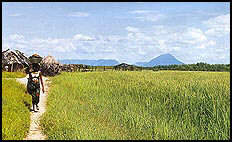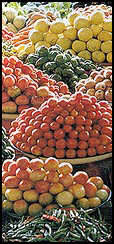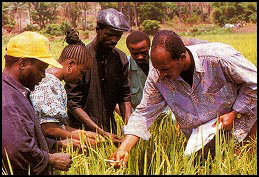 AGRICULTURE, THE WATER TOWER OF WEST AFRICA AGRICULTURE, THE WATER TOWER OF WEST AFRICA |

The agricultural potential in Guinea is enormous. More than 80% of the population is consecrated at least in part to agriculture. Industrial crops or agricultural exports, however only represent 8.6% of the country's exports, although the agricultural sector contributes 20.6% of the country's total GDP.
The Minister of Agriculture, His Excellency Jean Paul Sarr, underlines "on a whole agriculture constitutes the country's hope and is vital for Guinea and is its development motor, which is why it is the governments priority." With an annual growth of 5.5% only 2 million are in use. Having 6 million hectors of arable land to its disposal the government's first objective is to make Guinea self sufficient for it no longer to have to resort to imports. Second in line is the importance of exports increases in order to balance the country's balance of payments in order to achieve a sustainable economy. Finally the environmental aspect and the rationalization of the production is the third aspect of the government's policy regarding agriculture.
These objectives are defined and illustrated in the "Policy Letter for Agricultural Development", which is a drafted document elaborated by the government in 1991 in collaboration with its developmental partners. This letter defines the practices that must be held in each region; each of which is distinct in its own way.
In order to achieve these goals, the government relies on the assistance of the institute for Agricultural Research in Guinea (IRAG) which is present in every region to improve knowledge in the practical crops, improve its sowing quality and increase the output from each region, as well as on the local representatives and the civil populations. The latter, being directly affected and having a determining role in the process of development are consulted regularly.
The four regions that Guinea is composed of are: the lower region, the forest region, the middle region and the upper region.

Lower Guinea, also known as Maritime Guinea, is characterized by its practical mangrove crops. The IRAG established a research center that is based in Koba. The rice crop is essentially the one that is practiced in the mangroves. Coffee, tea, cotton, tobacco, peanuts and cacao, which are largely destined for exports, are also cultivated there.
The forest region is where the Niger finds its source and is characterized by its equatorial climate and its palm oil plantations, hevea and anacardier as well as rice, which is cultivated by the SOGUIPAH. The research center in Seredou works considerably on revaluing the export crops like coffee, bananas, or cacao. The latter crops had become almost inexistent during the past 10 years. Mid Guinea is constituted by the massive Fouta Djallon. It is known to concentrate mostly on fruits and vegetables. The research center in Bare, with the collaboration of non-governmental organizations were able to speed up the time between the planting of a tree and its harvesting from ten to five years.
Upper Guinea is considered is the savannah region of Guinea. The research center in Bordo relaunched the harvesting of cotton. The most important cities in the region, however, is Siguiri when it comes to rice harvesting. Like in all regions in Guinea the manioc, fonio, sorgho and potato crop are frequent, making up one of the main staple foods of the Guinean people.
After the first phase ended in 1996, the government incited farmers to unite in order to improve and rationalize their outputs. It also put channels and dikes in place in order to take advantage of the waters at the surface.
As explained by the Minister, Jean Paul Sarr, the results of the first phase consist in "elaborating a consensual document to define the objectives of the second phase, which means parting from the experiences of the population, to understand the existing constraints and then overcome them". Funding institutions such as the World Bank participated in the elaboration of this document. One example of international participation is the Program of Support to Village Communities (PACV) with which the French agency of development is associated, and is one of the best performing programs put into place. In 1998 another document defining the objectives of the second phase of the LPDA was adopted. Included in these objectives was the incrementing of crop production for exports, autosufficiency to be reached by 2005, the putting into place of a market agriculture, and the professional organization of agriculture. For the past 2 years the government has registered certain positive results, others however are far away from being reached.
| Regarding production growth and yield improvement some progress has been made. Rice production has gone from 500 000 to 800 000 tons per year, meaning a 30% decrease in imports. Other export products have also increased significantly in production since the establishment of the LPDA. This has been the case for coffee where the production has increased from 9000 tons at the beginning of the 1990's to 40 000 tons today. During the same period the annual production of mangos has gone from 100.000 to 300.000 tons and Cotton, which is still called the "white gold" of Guinea has been reintroduced and reached 40 000 tons of annual produce; especially in Kankan where production has achieved 25 000 tons. The creation of the Guinean Company of Cotton (CCG) has put its production goal at 200,000 tons for 2005 in order supply the drainage plant built in Kankan. Other crops have been launched, like cacao and tobacco, but the production is limited at a few thousand tons per year for the time being.
Companies such as Salguidia, Sobergui and Sobragui produce pineapples of which the total yield is of 30 000 tons.
The role of the Company of Guinean Palm Oil and heveas (Soguipah) is determined to improve their network. The yields obtained by them in the industrial plantations of Palm oil in Youmou in the forest region reached 17 tons per hectar and 30,000 tons yearly, and the hevea yield has been of 2 tons per hectar and 9000 tons annually.
In 1956 Guinea counted a production of 100,000 tons of bananas, superior in nature at the time of its neighbor Cote d'Ivoire. The state wants to launch a network and wants to start a program with the FAO which is looking into systematically reintroducing the banana in the zones of favorable crops, since the current level of production barely reaches 10% of what it was in 1956. In addition to refocusing on bananas the State wants to look at the potato, the onion, the avocado and the green beans and maybe even melon, and other citrus fruits as well. But these products still have sporadic yields and residual production, however.
The government continues to advance towards its objectives, which is to become auto sufficient. Two companies contribute strongly in making this objective possible: the Sino - Guinean company for the cooperation in agricultural development (SIGUICODA), which was created on January 6, 1997 and the Bernas Company. According to the minister of agriculture "the activities of the company fit perfectly in with the national priorities in terms of food security". SOGUICODA brought in its knowledge in terms of rice culture and already produces 4000 tons annually in the plains of Koba where it also breeds chickens, and has a factory for rice packaging. The know-how it transmits to the populations is a determining to attain the objectives of the State. The Bernas Company of Guinea also brings its know now in the rice and poultry sector. Fruit of the cooperation between Malaysia and Guinea, the essential objective according to the director general is "to assist Guinea to become auto sufficient, which is a necessary condition to develop the country". Situated in Monchon, the project has a departing capital of 3.4 million dollars and consists of a 800 ha rice farm and one chicken farm with 5,000 chickens. The outcome of this so-called south - south cooperation, is felt directly by providing the interior local market with its goods. This has resulted in the sharp reduction of rice imports equaling around 37 million USD. Considering the aforementioned impact, the government is trying to promote certain crops and bring quality seeds, irrigation and cultivatable land to the surface.

The training of farmers is also a necessary step. But the weight of traditions is considerable and time is needed to convince populations to start using certain techniques. "We are progressively trying to change the mentalities of our people" says Minister Sarr. The putting into place of agriculture unions is one of the instruments at their disposal. Certain groups have one tractor at their disposal, but a number of farmers have just learned to use animal traction, making it difficult to introduce new technology. According to the minister "one of the main hindrances is the absence of a development bank which subsisting farming. There are only small rural credits which have just been put in place by the government".
Guinea is still far from industrial agriculture even though. It still preserves its soil and favorizes biological crops in order not to destroy the natural cycle of the environment.
The disengagement of the state in the Agricultural Sector, will take some time. The methods of sowing and production are transmitted to the Guinean people. The position of the SOGUIPAH for example puts them in charge to favorise the economic and social development of the region. SOGUIPAH assists in that sense 3000 families for producing 4000ha of hevea, palm oil a soap company and the realization of rural hydraulique infrastructure, schools and a health center. The company transfers know how that will sustain the long term private iniciative. This realization applies also to other companies in Guinea since the liberalization of the economy. It is up to the people finally to take initiatives to take advantage of the still unexploited but formidable promising potential.
Guinea has justifyingly been named as "the castle of Water in West Africa", with dozens of rivers flowing through it and having an annual rainfall of 170 cm. Guinea is characterized by its climactic diversity. |

